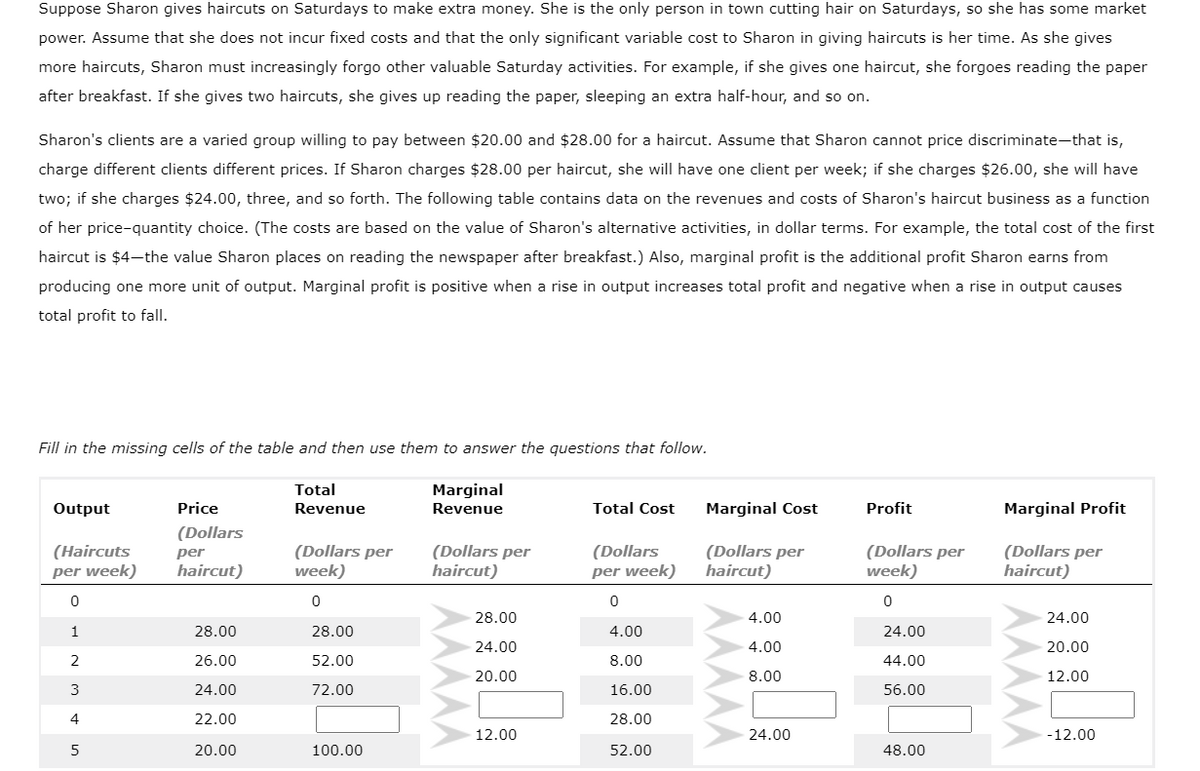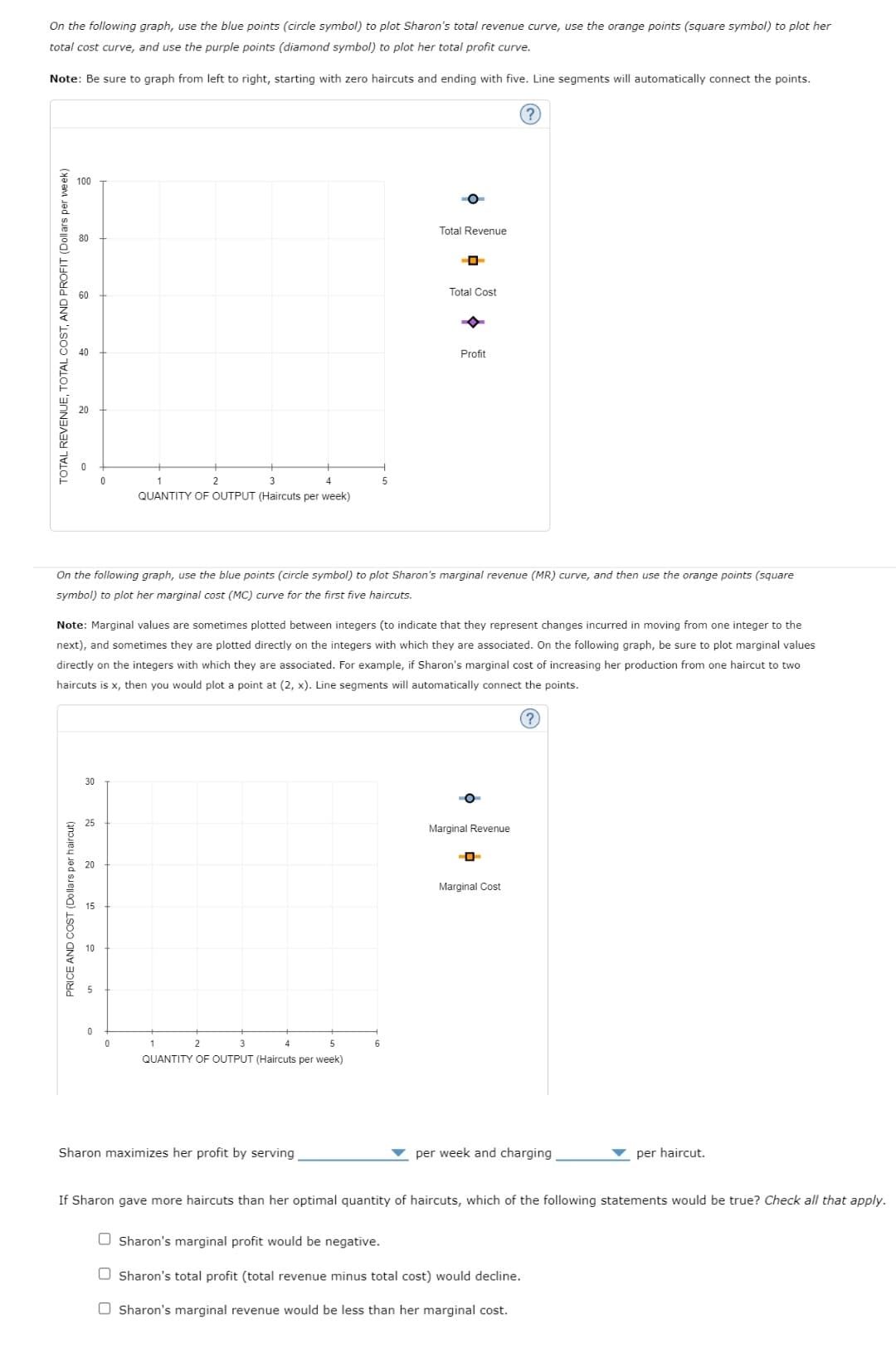Suppose Sharon gives haircuts on Saturdays to make extra money. She is the only person in town cutting hair on Saturdays, so she has some market power. Assume that she does not incur fixed costs and that the only significant variable cost to Sharon in giving haircuts is her time. As she gives more haircuts, Sharon must increasingly forgo other valuable Saturday activities. For example, if she gives one haircut, she forgoes reading the paper after breakfast. If she gives two haircuts, she gives up reading the paper, sleeping an extra half-hour, and so on. Sharon's clients are a varied group willing to pay between $20.00 and $28.00 for a haircut. Assume that Sharon cannot price discriminate-that is, charge different clients different prices. If Sharon charges $28.00 per haircut, she will have one client per week; if she charges $26.00, she will have two; if she charges $24.00, three, and so forth. The following table contains data on the revenues and costs of Sharon's haircut business as a function of her price-quantity choice. (The costs are based on the value of Sharon's alternative activities, in dollar terms. For example, the total cost of the first haircut is $4-the value Sharon places on reading the newspaper after breakfast.) Also, marginal profit is the additional profit Sharon earns from producing one more unit of output. Marginal profit is positive when a rise in output increases total profit and negative when a rise in output causes total profit to fall. Fill in the missing cells of the table and then use them to answer the questions that follow. Total Marginal Output Price Revenue Revenue Total Cost Marginal Cost Profit Marginal Profit (Dollars (Haircuts per week) (Dollars per week) (Dollars per haircut) (Dollars per week) (Dollars per haircut) (Dollars per week) (Dollars per haircut) per haircut) 28.00 4.00 24.00 1 28.00 28.00 4.00 24.00 24.00 4.00 20.00 2 26.00 52.00 8.00 44.00 20.00 8.00 12.00 3 24.00 72.00 16.00 56.00 4 22.00 28.00 12.00 24.00 -12.00 5 20.00 100.00 52.00 48.00
Suppose Sharon gives haircuts on Saturdays to make extra money. She is the only person in town cutting hair on Saturdays, so she has some market power. Assume that she does not incur fixed costs and that the only significant variable cost to Sharon in giving haircuts is her time. As she gives more haircuts, Sharon must increasingly forgo other valuable Saturday activities. For example, if she gives one haircut, she forgoes reading the paper after breakfast. If she gives two haircuts, she gives up reading the paper, sleeping an extra half-hour, and so on. Sharon's clients are a varied group willing to pay between $20.00 and $28.00 for a haircut. Assume that Sharon cannot price discriminate-that is, charge different clients different prices. If Sharon charges $28.00 per haircut, she will have one client per week; if she charges $26.00, she will have two; if she charges $24.00, three, and so forth. The following table contains data on the revenues and costs of Sharon's haircut business as a function of her price-quantity choice. (The costs are based on the value of Sharon's alternative activities, in dollar terms. For example, the total cost of the first haircut is $4-the value Sharon places on reading the newspaper after breakfast.) Also, marginal profit is the additional profit Sharon earns from producing one more unit of output. Marginal profit is positive when a rise in output increases total profit and negative when a rise in output causes total profit to fall. Fill in the missing cells of the table and then use them to answer the questions that follow. Total Marginal Output Price Revenue Revenue Total Cost Marginal Cost Profit Marginal Profit (Dollars (Haircuts per week) (Dollars per week) (Dollars per haircut) (Dollars per week) (Dollars per haircut) (Dollars per week) (Dollars per haircut) per haircut) 28.00 4.00 24.00 1 28.00 28.00 4.00 24.00 24.00 4.00 20.00 2 26.00 52.00 8.00 44.00 20.00 8.00 12.00 3 24.00 72.00 16.00 56.00 4 22.00 28.00 12.00 24.00 -12.00 5 20.00 100.00 52.00 48.00
Micro Economics For Today
10th Edition
ISBN:9781337613064
Author:Tucker, Irvin B.
Publisher:Tucker, Irvin B.
Chapter2: Productions Possibilities, Opportunity Costs, And Economic Growth
Section: Chapter Questions
Problem 10SQP
Related questions
Question

Transcribed Image Text:Suppose Sharon gives haircuts on Saturdays to make extra money. She is the only person in town cutting hair on Saturdays, so she has some market
power. Assume that she does not incur fixed costs and that the only significant variable cost to Sharon in giving haircuts is her time. As she gives
more haircuts, Sharon must increasingly forgo other valuable Saturday activities. For example, if she gives one haircut, she forgoes reading the paper
after breakfast. If she gives two haircuts, she gives up reading the paper, sleeping an extra half-hour, and so on.
Sharon's clients are a varied group willing to pay between $20.00 and $28.00 for a haircut. Assume that Sharon cannot price discriminate-that is,
charge different clients different prices. If Sharon charges $28.00 per haircut, she will have one client per week; if she charges $26.00, she will have
two; if she charges $24.00, three, and so forth. The following table contains data on the revenues and costs of Sharon's haircut business as a function
of her price-quantity choice. (The costs are based on the value of Sharon's alternative activities, in dollar terms. For example, the total cost of the first
haircut is $4-the value Sharon places on reading the newspaper after breakfast.) Also, marginal profit is the additional profit Sharon earns from
producing one more unit of output. Marginal profit is positive when a rise in output increases total profit and negative when a rise in output causes
total profit to fall.
Fill in the missing cells of the table and then use them
answer the questions that follow.
Total
Marginal
Output
Price
Revenue
Revenue
Total Cost
Marginal Cost
Profit
Marginal Profit
(Dollars
(Dollars per
haircut)
(Dollars
per week)
(Dollars per
haircut)
(Dollars per
week)
(Dollars per
haircut)
(Haircuts
(Dollars per
week)
per
per week)
haircut)
28.00
4.00
24.00
1
28.00
28.00
4.00
24.00
24.00
4.00
20.00
2
26.00
52.00
8.00
44.00
20.00
8.00
12.00
3
24.00
72.00
16.00
56.00
4
22.00
28.00
12.00
24.00
-12.00
5
20.00
100.00
52.00
48.00

Transcribed Image Text:On the following graph, use the blue points (circle symbol) to plot Sharon's total revenue curve, use the orange points (square symbol) to plot her
total cost curve, and use the purple points (diamond symbol) to plot her total profit curve.
Note: Be sure to graph from left to right, starting with zero haircuts and ending with five. Line segments will automatically connect the points.
100
Total Revenue
80
Total Cost
Profit
4.
QUANTITY OF OUTPUT (Haircuts per week)
On the following graph, use the blue points (circle symbol) to plot Sharon's marginal revenue (MR) curve, and then use the orange points (square
symbol) to plot her marginal cost (MC) curve for the first five haircuts.
Note: Marginal values are sometimes plotted between integers (to indicate that they represent changes incurred in moving from one integer to the
next), and sometimes they are plotted directly on the integers with which they are associated. On the following graph, be sure to plot marginal values
directly on the integers with which they are associated. For example, if Sharon's marginal cost of increasing her production from one haircut to two
haircuts is x, then you would plot a point at (2, x). Line segments will automatically connect the points.
(?
30
25
Marginal Revenue
20
Marginal Cost
15
QUANTITY OF OUTPUT (Haircuts per week)
Sharon maximizes her profit by serving
per week and charging
per haircut.
If Sharon gave more haircuts than her optimal quantity of haircuts, which of the following statements would be true? Check all that apply.
O Sharon's marginal profit would be negative.
O Sharon's total profit (total revenue minus total cost) would decline.
O Sharon's marginal revenue would be less than her marginal cost.
TOTAL REVENUE, TOTAL COST, AND PROFIT (Dollars per week)
PRICE AND COST (Dollars per haircut)
Expert Solution
This question has been solved!
Explore an expertly crafted, step-by-step solution for a thorough understanding of key concepts.
This is a popular solution!
Trending now
This is a popular solution!
Step by step
Solved in 2 steps with 1 images

Recommended textbooks for you








Microeconomics: Private and Public Choice (MindTa…
Economics
ISBN:
9781305506893
Author:
James D. Gwartney, Richard L. Stroup, Russell S. Sobel, David A. Macpherson
Publisher:
Cengage Learning

Economics: Private and Public Choice (MindTap Cou…
Economics
ISBN:
9781305506725
Author:
James D. Gwartney, Richard L. Stroup, Russell S. Sobel, David A. Macpherson
Publisher:
Cengage Learning